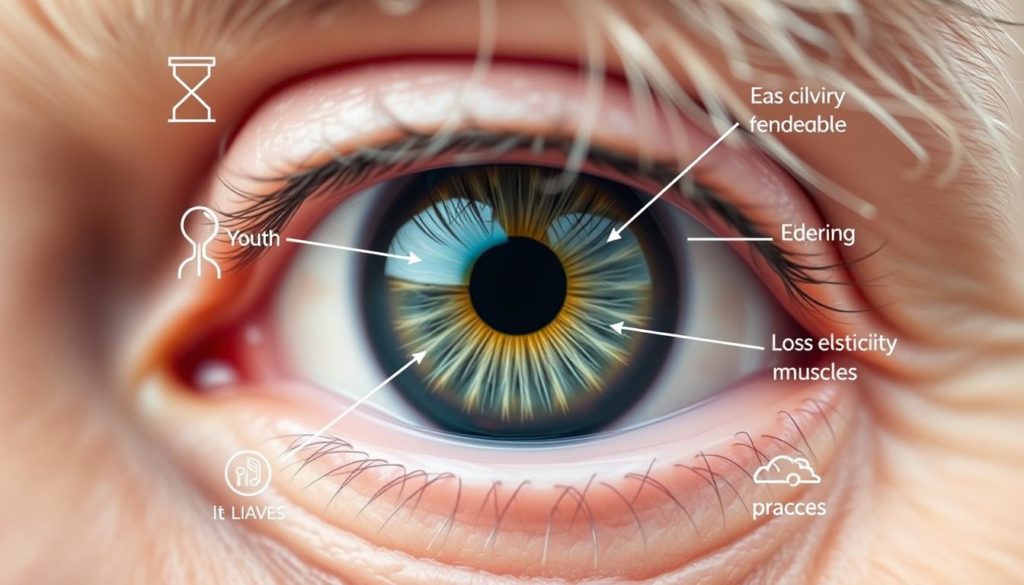Did you know nearly 100% of people over 50 will get presbyopia? This shows how common age-related vision changes are. It’s something almost everyone faces as they get older.
Presbyopia is a common vision problem that starts in the 40s. It’s a natural part of aging for our eyes. It makes it harder to see things up close.
By taking care of our eye health, we can deal with presbyopia better. It’s important to watch how our vision changes as we age.
What Is Presbyobia?
Presbyopia is a common eye condition that makes it hard to focus on close objects. It starts to show up in people over 40. Unlike other vision problems, presbyopia only affects near vision because of changes in the eye’s lens.

Presbyopia Definition
Presbyopia is when the eye’s lens loses its flexibility. This flexibility is key for focusing on objects at different distances. As we age, the lens becomes less flexible, making it tough to see close-up details clearly. Understanding presbyopia helps us see it as a natural part of aging.
How Presbyopia Affects Vision
Presbyopia can make everyday tasks hard. You might struggle to read small text or need to hold things farther away. It can also cause headaches or eye strain when doing close-up work. This condition mainly affects near vision, not distant vision.
Collaboration with Aging
As we get older, our bodies change, and presbyopia is one of these changes. The lens and muscles around it lose their elasticity, leading to poor near vision. Keeping an eye on any changes in your vision can help manage presbyopia.
Causes of Presbyopia
Presbyopia is an age-related eye condition. It mainly comes from two main reasons: the eye’s lens losing its elasticity and the ciliary muscles getting weaker. These changes make it hard for the lens to focus on close objects.

As we get older, the lens in our eyes becomes less flexible. This makes it hard to focus on things up close. The ciliary muscles, which help the lens focus, also weaken with age. This makes focusing even harder.
Here’s a quick look at what causes presbyopia:
| Factor | Impact |
|---|---|
| Loss of Lens Elasticity | Reduces the ability of the lens to change shape for focusing on close objects |
| Weakening of Ciliary Muscles | Decreases the capability to assist in focusing through lens adjustments |
Recent studies in ophthalmology back up these findings. A study in the *Journal of the American Medical Association* shows that the lens’s rigidity and the ciliary muscles’ weakness are key to understanding presbyopia.
Understanding these biological changes helps us see why presbyopia happens as we age. The hardening lens and weakening muscles together limit our near vision.
Symptoms of Presbyopia
It’s important to know the signs of Presbyopia to manage it well. Let’s explore these common symptoms.
Difficulty Reading Small Print
One of the first signs of Presbyopia is trouble reading small text. This can be anything from a book to your phone’s screen. The letters may blur as Presbyopia gets worse. This happens because the eye’s lens can’t focus as well on close objects.
Need for Brighter Light
As Presbyopia gets worse, you might need more light to see. Reading in dim places becomes hard. Brighter light helps reduce eye strain and makes reading easier. But it shows your vision is changing.
Eye Strain and Headaches
Struggling to see can cause headaches and eye strain. These problems happen after a lot of reading or close work. They can really affect your comfort and work. Spotting these signs early helps you make changes to feel better and keep your eyes healthy.
Treatment for Presbyopia
Presbyopia makes it hard to focus on close things. Luckily, there are many ways to fix this problem. You can try non-invasive options like glasses and contacts, or go for more lasting solutions with surgery.
Eyeglasses
Presbyopia eyeglasses are a common fix. They often come as bifocals or progressive lenses. Bifocals have two lens powers for near and far vision. Progressive lenses change smoothly without visible lines.
Contact Lenses
For those who don’t like glasses, contact lenses for Presbyopia are a good choice. Multifocal lenses have different zones for near and far vision. Monovision contacts use one eye for near and the other for far. Both types work well to reduce presbyopia’s effects.
Surgical Options
Surgical options for Presbyopia offer lasting fixes. LASIK and CK reshape the cornea for better near vision. Lens implants replace the natural lens for sharper focus. These surgeries need a doctor’s advice to find the right fit for you.
Presbyopia Diagnosis
Learning about Presbyopia diagnosis can make you feel more comfortable when you see your optometrist. It starts with a detailed eye check-up and then specific tests.
Eye Examination
An eye check is key to finding out if you have Presbyopia. Your optometrist will look at your vision and check for eye health problems. They will ask about your medical history and any vision issues you have. They will also do a vision test with an eye chart.
Diagnostic Tests
To get a clear diagnosis, your optometrist will do several tests. These include a refraction test to find the right lens prescription. They also check how well your eyes focus light and how flexible your lenses are. These tests help confirm if you have Presbyopia and how severe it is, so you can get the best treatment.
| Test | Purpose | Details |
|---|---|---|
| Vision Test | Assess clarity of vision | Using an eye chart |
| Refraction Assessment | Determine lens prescription | Measure light focus |
| Flexibility Test | Check lens flexibility | Assess light accommodation |
Managing Presbyopia
Presbyopia is a common condition that affects nearly everyone as they age. While it can’t be prevented, there are many ways to manage it. Adjustments and adaptive strategies are key to maintaining your quality of life.
One of the simplest yet most effective methods for managing Presbyopia is adjusting your lighting. Proper lighting can make a huge difference when reading or performing tasks that require close vision. Consider using bright, focused light where needed, such as reading lamps with adjustable brightness.
Magnification is another useful tool. Various magnifying devices, from handheld magnifiers to digital magnifiers, can significantly aid in managing Presbyopia. Use them to read small print on labels, documents, or when performing detailed tasks.
Technology has provided an array of devices and applications to assist those managing Presbyopia. Smartphone and tablet apps can enlarge text or use voice-activated features to read text aloud. E-readers with adjustable font sizes and backlighting also offer great flexibility for comfortable reading.
Here are some helpful tips:
- Increase text size on electronic devices.
- Use reading glasses or bifocal lenses as recommended by your eye care professional.
- Maintain good posture and appropriate book or screen distance to reduce eye strain.
Let’s break down these strategies for managing Presbyopia:
| Solution | Description | Benefits |
|---|---|---|
| Improved Lighting | Use bright, adjustable lamps | Reduces strain, improves visibility |
| Magnification Tools | Handheld magnifiers, digital zoom | Enhances clarity of small text |
| Technology Aids | Apps, e-readers with large fonts | Convenience and flexibility |
By integrating these adaptive techniques into your daily life, managing Presbyopia becomes a more manageable task. This helps you maintain your independence and quality of life.
Presbyopia Prevention
Learning how to prevent Presbyopia can help keep your vision healthy as you get older. Making smart lifestyle choices and checking your eyes regularly are key.
Healthy Lifestyle Choices
Living a healthy lifestyle for eyes is vital in stopping Presbyopia. Eating foods full of antioxidants, like leafy greens and fish with omega-3, is a good start. Also, wearing sunglasses with UV protection helps shield your eyes from harm.
Regular Eye Checkups
Getting regular eye checkups is also crucial. These visits help doctors spot vision changes early. This way, you can get the right care and advice to keep your eyes healthy.
Exercises for Presbyopia
Presbyopia exercises are getting attention as ways to ease age-related vision issues. While glasses or contact lenses are the main treatment, some think eye exercises can help. They believe these exercises can strengthen eye muscles and keep the lens flexible, possibly slowing presbyopia.
One exercise involves focusing on a pencil at arm’s length and then moving it closer to your nose. This is thought to improve how well your eyes adjust to near and far objects. Another exercise is making figure-eight motions with your eyes to boost eye movement and coordination. These simple exercises might help improve your vision.
But, the scientific community has mixed views on these exercises. Some small studies and personal stories show benefits, but big, clear research is missing. Groups like the American Academy of Ophthalmology say eye exercises shouldn’t replace traditional treatments. They warn that while these exercises might help eye health, they won’t cure presbyopia.
In short, presbyopia exercises could be a helpful addition to eye care. Adding them to your routine might offer some benefits. But, it’s key to use proven treatments like glasses or surgery for better results. Always talk to a doctor before starting any new exercise to make sure it’s right for you.
FAQ
What is Presbyopia?
Presbyopia is a vision change that happens as we age. It makes it hard to focus on things up close. It usually starts in the 40s and affects many people worldwide.
How does Presbyopia affect vision?
Presbyopia makes the lens in your eye lose its shape. This makes it hard to see things that are close. You might find it hard to read small print or see details up close.
What are the causes of Presbyopia?
Presbyopia happens because the lens in your eye loses its flexibility. The muscles that help the lens change shape also weaken with age. These changes are part of getting older.
What are common symptoms of Presbyopia?
Symptoms include trouble reading small text and needing more light to read. You might also get eye strain and headaches, especially after doing close work for a long time.
How is Presbyopia diagnosed?
A doctor will do a thorough eye exam to diagnose Presbyopia. This includes a vision test and other tests to see how bad it is.
What treatments are available for Presbyopia?
Treatments include glasses with bifocal or progressive lenses. There are also contact lenses and surgeries like LASIK or lens implants.
Are there any exercises that help with Presbyopia?
Some eye exercises are suggested to strengthen the muscles. But, how well they work can vary. Always talk to an eye doctor for advice and realistic hopes.
Can Presbyopia be prevented?
While you can’t stop Presbyopia completely, you can slow it down. Eating well, protecting your eyes from UV rays, and getting regular eye exams can help.
How can I manage Presbyopia in daily life?
To manage Presbyopia, use good lighting and magnification tools. Try technology that helps with reading and close work. Regular eye exams and finding ways to adapt can improve your life quality.


